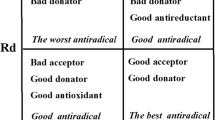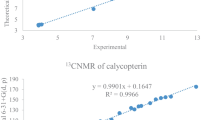Abstract
Ommochromes are colored substances that apparently function as biological signals among arthropods and insects. These substances may prevent oxidative stress by scavenging free radicals. Two principal mechanisms exist for scavenging free radicals: the electron transfer and hydrogen atom transfer. In this investigation, a theoretical study of the antiradical capacity of five ommochromes was performed within the density functional theory framework. Vertical ionization energy and vertical electron affinity were used to study the electron transfer mechanism between ommochromes and four free radicals: CH3O•, NO2•, HO•, and HOO•. For the hydrogen transfer mechanism, dissociation energy (D0) and Gibbs free energy were calculated, taking into account hydrogen atoms at different positions in the ommochromes. Both mechanisms are thermodynamically possible. The best antiradical is ommatin D. The UV/VIS spectra for ommochromes were obtained with ommatin D registering as the ommochrome with the greatest λmax value. In summary, ommatin D is the best antiradical and also the redder molecule. These results are important and may help to elucidate the function of these molecules in the animal kingdom.

Ommochromes are red and yellow substances present in arthropods and insects. According with computational chemistry, these substances present the capacity of prevent oxidative stress since they scavenge free radicals. These results may help to elucidate the function of these molecules in the animal Kingdom



Similar content being viewed by others
References
Choi J, Corder NLB, Koduru B, Wang Y (2014) Free Rad Biol Med 72:267
Saeidnia S, Abdillahi M (2013) Tox App Pharma 273:442
Yan MH, Wang X, Zhu X (2013) Free Rad Biol Med 62:90
Lin MT, Beal MF (2006) Nature 443:787
Reddy PHJ (2006) Neurochem 96:1
Schoencich C (2005) Biochim Biophys Acta 1703:111
Giasson BI, Ischiropoulos H, Lee VMY, Trojanowsky JQ (2002) Free Rad Biol Med 32:1264
Perry G, Raina AK, Nunomura A, Wataya T, Sayre LM, Smith MA (2000) Free Rad Biol Med 28:831
Perry G, Castellani RJ, Hirai K, Smith MA (1998) J Alzheimer's Dis 1:45
Burton GW, Ingold KU (1984) Science 224:569
Martínez A, Barbosa A (2008) J Phys Chem B 112:16945
Martínez A, Rodríguez-Gironés MA, Barbosa A, Costas M (2008) J Phys Chem A 112:9037
Avelar M, Martínez A (2012) J Mex Chem Soc 56:250
Martínez A (2009) J Phys Chem B 113:4915
Martínez A, Vargas R, Galano A (2009) J Phys Chem B 113:12113
Galano A (2007) J Phys Chem B 111:12898
Martínez A, Hernández-Marin E, Galano A (2012) Food Funct 3:442
Riou M, Christidès JP (2010) J Chem Ecol 36:412
Thery M, Casas J (2002) Philos Trans R Soc Lond B Biol Sci 363:471
Wadano A, Takenaka Y, Matumoto M (1993) Insect Biochem Molec Biol 23:919–925
Lugo-Huitrón R, Blanco-Ayala T, Ugalde-Muñiz P, Carrillo-Mora P, Pedraza-Chaverrí J, Silva-Adaya D, Maldonado PD, Torres I, Pinzón E, Ortíz-Islas E, López T, García E, Pineda B, Torres-Ramos M, Santamaría A, La Cruz VP (2011) Neurotoxicol Teratol 33:538
Linzen B (1974) Adv Insect Physiol 10:177
Colín-González AL, Maldonado PD, Santamaría A (2013) NeuroToxicol 34:189
Wang Y, Liu H, McKenzie G, Witting PK, Stasch JP, Hahn M, Changsirivathanathamrong D, Wu BJ, Ball HJ, Thomas SR, Kapoor V, Celermajer DS, Mellor AL, Keaney JF Jr, Hunt NH, Stocker R (2010) Nat Med 16:279
Nguyen NT, Kimura A, Nakahama T, Chinen I, Masuda K, Nohara K, Fujii-Kuriyama Y, Kishimoto T (2010) Proc Natl Acad Sci USA 107:19961
Zelentsova E, Sherin P, Snytnikova O, Kaptein R (2013) Photochem Photobiol Sci 12:546
Halgren TA (1996) J Comp Chem 17:490
Halgren TA (1996) J Comp Chem 17:520
Halgren TA (1996) J Comp Chem 17:553
Halgren TA, Nachbar RB (1996) J Comp Chem 17:587
Halgren TA (1996) J Comp Chem 17:616
Gaussian 09, Revision C.01, Frisch MJ, Trucks GW, Schlegel HB, Scuseria GE, Robb MA, Cheeseman JR, Scalmani G, Barone V, Mennucci B, Petersson GA, Nakatsuji H, Caricato M, Li X, Hratchian HP, Izmaylov AF, Bloino J, Zheng G, Sonnenberg JL, Hada M, Ehara M, Toyota K, Fukuda R, Hasegawa J, Ishida M, Nakajima T, Honda Y, Kitao O, Nakai H, Vreven T, Montgomery JA, Peralta JE, Ogliaro F, Bearpark M, Heyd JJ, Brothers E, Kudin KN, Staroverov VN, Kobayashi R, Normand J, Raghavachari K, Rendell A, Burant JC, Iyengar SS, Tomasi J, Cossi M, Rega N, Millam JM, Klene M, Knox JE, Cross JB, Bakken V, Adamo C, Jaramillo J, Gomperts R, Stratmann RE, Yazyev O, Austin AJ, Cammi R, Pomelli C, Ochterski JW, Martin RL, Morokuma K, Zakrzewski VG, Voth GA, Salvador P, Dannenberg JJ, Dapprich S, Daniels AD, Farkas O, Foresman JB, Ortiz JV, Cioslowski J, Fox DJ (2009) Computational models. Gaussian Inc, Wallingford
Becke AD (1998) Phys Rev A 38:3098
Mielich B, Savin H, Stoll H, Peuss H (1989) Chem Phys Lett 157:200
Lee C, Yang W, Parr RG (1988) Phys Rev B 37:785
Marenich AV, Cramer CJ, Truhlar DG (2009) J Phys Chem B 113:6378
Acknowledgment
This study was funded by DGAPA-PAPIIT, Consejo Nacional de Ciencia y Tecnología (CONACyT), and resources provided by the Instituto de Investigaciones en Materiales (IIM). This work was carried out using a NES supercomputer, provided by Dirección General de Cómputo y Tecnologías de Información y Comunicación (DGTIC), Universidad Nacional Autónoma de México (UNAM). We would like to thank the DGTIC of UNAM for their excellent and free supercomputing services. Yanet Romero thanks CONACyT by scholarship number 202990.
Author information
Authors and Affiliations
Corresponding author
Electronic supplementary material
Below is the link to the electronic supplementary material.
ESM 1
(DOCX 23203 kb)
Rights and permissions
About this article
Cite this article
Romero, Y., Martínez, A. Antiradical capacity of ommochromes. J Mol Model 21, 220 (2015). https://doi.org/10.1007/s00894-015-2773-3
Received:
Accepted:
Published:
DOI: https://doi.org/10.1007/s00894-015-2773-3




